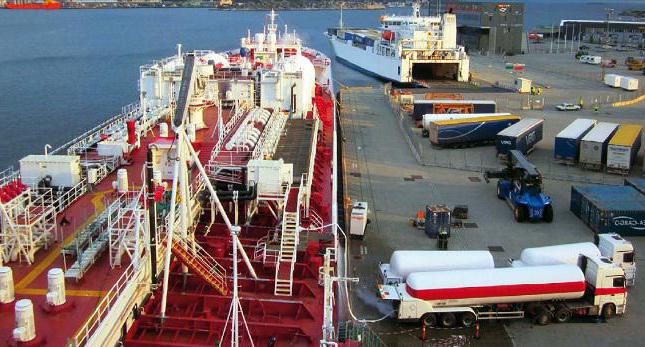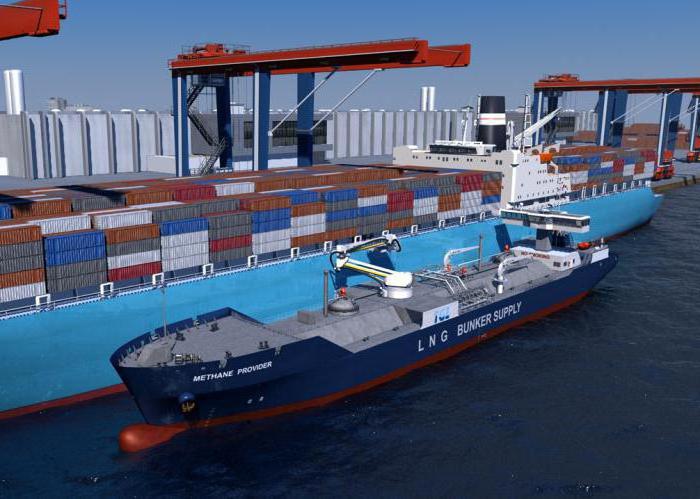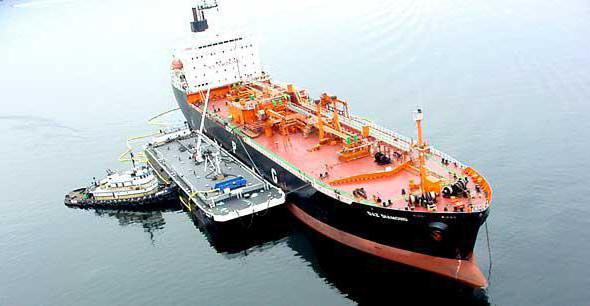It is customary to call the bunkering of a vessel its refueling not only fuel, but also motor oils. Moreover, the bulk of the work in this event is precisely the preparatory work. The success of the whole procedure depends on the quality of their implementation.
General Bunkering Concepts
There are several ways to carry out such an operation as refueling. Different types of vessels can choose the most suitable methodology for themselves. It is quite possible to carry it out:
- At the pier.
- On the run.
- On the roads.
- In a drift in the sea or ocean, etc.

Transport, which is engaged in the delivery of fuels and lubricants to the ship, is usually called a bunker. In fact, it is a tanker designed for bunkering. The vessel to which the delivery of fuels and lubricants is directly called bunker.
Bunkering process manufacturing technology
To replenish the reserves of fuels and lubricants, it is possible to resort to the use of various methods. One of them is refueling from the pier. With this method, fuel is delivered from the shore using a tanker, pipeline. It is also possible to carry out these actions at the berth from the tanker, provided that it is moored to the berth.
The second method is bunkering the vessel at anchor. With this method, they should both be anchored.
Another way could be to refuel on the go or in a drifting state. This technique is most often used by fishing types of vessels in the fishery.
The implementation of a small type of bunkering
Fuel bunkering is not necessarily carried out by a tanker. For refueling elements belonging to the small fleet, a CCD (floating gas station) can be used. At the same time, it can supply not only gasoline, but also diesel fuel for yachts and motor ships of small sizes.
The implementation of the bunkering process of the vessel
First of all, the fuel supplied in the process of replenishing fuel and lubricants, whether gasoline or diesel fuel, must meet certain requirements and be suitable for use in engines of a certain type. Bunkering should only be carried out after receipts have been verified and the responsible personnel are satisfied that all the stated viscosity and density standards are met. Otherwise, equipment malfunctions may occur, and it may fail, and no one is interested in this.

As practice shows, most consumers are in no way focused on the quality and compliance of all necessary fuel requirements with the declared ones, but primarily on the price. The primary characteristic of the supplied fuel is its calorific value. Many do not pay attention to this, but if it does not meet the declared norm, the consumer has the right to demand compensation. On delivery receipts, some suppliers marked as unscrupulous may increase fuel density. In this regard, the buyer pays for undelivered goods.
Bunkering of a vessel may be complicated or delayed for an indefinite period if the water level is exceeded in the fuel. This not only reduces the declared quality of the delivered goods, but can also lead to problems with the operation of the equipment. If the supplier is not able to ensure the delivery of goods with the relevant requirements, then with a greater likelihood he must agree to lower the price of the goods.

Only with the right approach to the consideration of all conditions and the correct conclusion of the contract is a fast and high-quality bunkering of the vessel possible. All responsible persons should be very careful to ensure that the fuel is supplied in good quality and meets the stated requirements. Otherwise, technical malfunctions will be inevitable up to the point that the ship will not be able to go to sea.
Aircraft bunkering requirements
It is allowed to replenish the ship’s reserves with fuels and lubricants only in a closed way. In this case, the use of connecting devices is allowed. Special bunkering vessels carry out this operation. The manufacturer recommends the use of a particular type of fuel when releasing the engine. These recommendations should certainly be followed when carrying out all appropriate actions.
Storage of fuel and lubricants is carried out only in special tanks that meet certain standards and requirements.
Safety precautions that must be observed when bunkering vessels
There are certain requirements for refueling vessels, which are subject to certain rules and regulations. So, before you begin to carry out these actions and supply fuel, an alert is made about this operation. It is announced on which board this action will be carried out, as well as on compliance with the necessary rules regarding fire safety when performing these actions.
When bunkering on the mast of the vessel, the flag “B” flies, and at night the red circular light turns on. In the place where the hose was made, a fire station is organized with all the necessary means to extinguish the fire. A fire line equipped with a foam barrel is also laid. The signs “Smoking is prohibited” and “Passage are prohibited” are set at the place of reception and transfer of fuel. All fire fighting equipment on board is also involved.

Bunkering at night
If bunkering operations are carried out in the dark, then the venue should be lit as much as possible. It is also worth pre-instructing all the people who will take part in carrying out these actions.
Before refueling, you need to check the amount of fuel in the tanks that is already available. It also specifies how much fuel must be supplied. After all these measures, the moment of the sequence of filling the tanks is agreed upon, as well as the serviceability of overflow devices and signaling devices.
In those places where the hoses are connected, as well as under the fittings, it is customary to install pallets in case there is a leak. All deck scuppers are drowned out, since it is through them that fuel and lubricants can enter the water.

In the place where the fuel is directly received, rags are prepared and used that sorb the materials.
Upon receipt of each batch of fuel, a sample is taken from it. It is stored on the ship until the delivered batch is over.
Communication with the watch commander of the bunkering station is maintained using a specialized portable radio station.
The operating pressure used during bunkering must be agreed upon by the person in charge with the officer in charge of the bunkering station.
International bunkering requirements
At the present time, it is very important to comply with all the rules for the bunkering of ships, since regulations regarding the pollution of water open spaces have entered into force. According to them, excessive amounts of oil products and fuels and lubricants are not allowed to enter the water.

Responsibility for their non-compliance is envisaged at the international level, therefore it is strongly discouraged to violate established standards. The consequences can be very adverse. Ship bunkering rules oblige not only to comply with generally accepted safety rules, but also to comply with international environmental protection rules.
